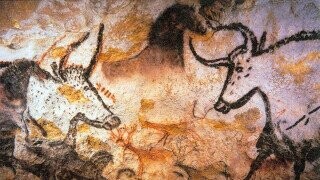The Cave Animation Work Of Pre-Historic Walt Disneys

When early humans of the Paleolithic era created cave art, they weren't just finger painting to pass the time. For them, grottos and caves were their stages and manipulating those spaces meant communication amongst themselves and entertainment for the night. It's all they had because, let's not forget, they were still at least like 10 years away from the very first meme. (Historians still debate if it was "Distracted Thag" or "Crying Cronk.")
Earth's dimly-lit crevices were amongst their favorite places to draw, yet dark were the spaces surrounding them. Sunlight couldn't properly light the caves, and this has been a topic of wonder for researchers. Were cave people submitting stories for the approval of The Paleolithic Midnight Society in the dark with grand, over-exaggerated gestures? A study was recently conducted where archeologists recreated prehistoric stone lamps, bonfires, and torches to see if these illustrations could be viewed using the tools of early inhabitants and for how long. The result? They found that some paintings could only be seen with artificial light.
Cave paintings discovered in Northern Spain, known as the Atxurra Cave, were located "so deep into the cave that they would only have been visible with added light." These archeologists found that torches worked, though with a low life span, still allowing the illustrations to be seen and with a twist- the drawings, under the flicker of firelight, could be made to look like they were moving.
Don't Miss
When the Lascaux cave paintings of France were found in 1940 by a group of teens who followed their dog into a cavern, just like it would play out in an adventure movie, the art was discovered to be over 15,000 years old, most likely used as a "center for hunting and religious rites."
Cave pictures of bison could appear as if they were bouncing, horses could be steered by the light to look like they were galloping. This art form suggests that early cave dwellers created the youngest version of animation. Shadows could be cast to make images appear smaller or larger, to ensure that drama was a part of the Paleolithic Cinematic Universe. However, as many tourists have made the mistake of bringing in their giant flashlights into ancient caves, and Nautilus points out, "When you light the whole cave, it is very stupid because you kill the staging." In other words, the early people had a vibe not to be messed with.
It is also suggested that light could have created a party-esque tone- "a flickering flame in the cave may have conjured impressions of motion, like a strobe light in a dark club." So not only were early humans makers of animation but perhaps involved in the first-ever club scene.
According to the Long Now Foundation, these cave dwellers were inventors of sequential animation. The same animal could be depicted in different motions as a continuous image, and adding light gave the art its impression of movement.
As today's animation comes in many looks and genres, early humans drew the way into the motion picture scene. Researchers have suggested that the Paleolithic way of enjoying entertainment had a warmth associated with it, one you'll certainly never get from a GIF of Rachel from Friends nodding yes as a quick text reply. And here we are today, contrary to popular belief, animation did not begin with technology, but rather lack thereof.
Top Image: Prof saxx/Wiki Commons